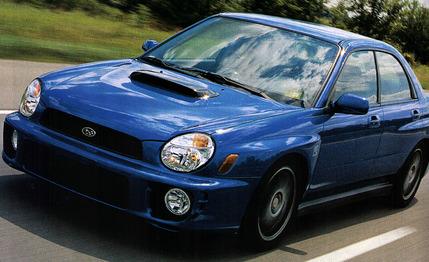 Specialty File
Specialty File
About five times a month we get a call that goes like this: "Hello, Car and Driver? This is Joe Dingo, from [insert favorite car here] Performance Systems, and we gotta killer [insert same car as above] that'll blow the doors offa anything! Whaddya say you guys do a story on it?"
We're picky, because space in the magazine is always at a premium. Maybe 10 of these "enhanced" cars are written about in a year. We cannot tell a lie: If the caller has a modified version of one of our favorite production cars, his chances suddenly get better.
Such was the case with the M2 WRX you see here. And we appreciate that when Brian Richards, the owner and founder of M2 Performance, was told about the hard-driving regime his modified Subaru Impreza WRX would undergo, his attitude was, "Bring it on, bro."
M2 Performance is located in Concord, California, in the San Francisco Bay area. Founded in 1994, Richards's business had focused mainly on modifying and racing Mazda RX-7s, cars that were last sold in the U.S. in 1995. Although there still are RX-7 owners buying materials from M2, Richards needed to broaden his product line. Enter the WRX. Last August he brought us a WRX with his $12,995 M2 WRX package that included engine, suspension, wheel, tire, and brake upgrades.
The final tab for our test car, which includes the $24,520 price of a 2002 WRX sedan, the M2 WRX package, and a set of $1400 Sparco racing seats, came to $38,915. Youch! That demonstrates the problem faced by all tuners, which is to say, that kind of money will get you a 225-hp BMW 330i or a 287-hp Nissan 350Z or a 225-hp Audi TT or a 390-hp Ford SVT Mustang Cobra. A few grand more and you could be stylin' in a 350-hp Vette.
On the other hand, the M2 WRX can keep up with the big dogs of that group. The little buzz bomb sprinted to 60 mph in 4.4 seconds—0.1 second quicker than the SVT Cobra. It zipped through the quarter-mile in 12.9 seconds at 107 mph; the Cobra did it in 12.9 seconds at 111 mph. Those numbers trounce a stock WRX's figures. When our long-term WRX was new, it needed 5.9 seconds to reach 60—1.5 seconds behind an M2's time—and did the quarter in 14.6 seconds at 93 mph.
Attaining those stellar times wasn't exactly easy. The WRX's standard four-wheel drive offers gobs of traction, so spinning the tires in a drag-strip launch was out. That meant we had to maniacally slip the clutch to get the best times. We did 10 such launches with no ill effects.
We mention this because the list of parts that are changed or upgraded on the WRX's 2.0-liter turbocharged flat-four engine does not include a new, stronger clutch, the part that takes the most abuse during testing. Richards says the stock clutch can handle the increased power, and according to our experience, he's right. There are, however, a new, larger turbocharger, a larger intercooler, a stainless-steel exhaust system, and an aftermarket engine computer, called the ChipTorque XEDE, that piggybacks onto the stock computer. No internal engine modifications are required with these parts.
As with most high-performance parts, the object is to get more fuel and air into the cylinders. The larger turbo can pump more air than can the stock unit, and like the stock engine computer, the XEDE computer varies turbo boost (depending on engine temperature) up to a maximum of 16.5 psi, about 3 psi more than stock. The larger intercooler lowers intake-air temperature (for another horsepower increase), and M2 reprograms the piggyback engine computer to complement the increased airflow with more fuel.
The result is 320 horsepower at 6300 rpm and 305 pound-feet of torque at 6000 rpm; stock WRXs have 227 horsepower and 217 pound-feet of torque. There's some turbo lag with this motor, especially when the revs are below three grand. But feeling that intense rush as the turbo comes to full boil is fun in its own way, and the four-wheel-drive system transfers all the power to the ground without upsetting the car.
We got addicted to those turbo-fueled power pulses while slogging on the highway, purposely slowing to 30 mph and then cranking it up to 100 or so. We were also hard on the M2 brakes, which use larger rotors and calipers at each corner. But they didn't show any hint of fade on the highway or at the track, where they stopped the car from 70 mph in 179 feet, nine better than our long-termer.
Our experience on the highway uncovered one aspect of the package that we'd change: the suspension stiffness. For track work, the M2's stiffer struts and springs-with adjustments for shock damping and ride height-are perfect. There's more grip than from the stocker (0.90 g versus 0.81), and the car is wonderfully neutral while cornering. Maybe we're getting soft, but that racetrack-tuned suspension felt too harsh on our frost-heaved roads.
In the world of performance tuning, $12,995 usually doesn't get you much. Remember the "Supercar Challenge" in last September's issue? None of those cars had engine mods that cost less than 20 grand. Sure, most were faster than the M2 WRX, but with the M2 package you get the engine stuff and brakes, wheels, tires, and suspension. It's a good deal.
M2 Performance, 2111 Fremont Street, Concord, California 94520; 925-686-9047; www.m2performance.com